Abstract
To investigate the possible role of insulin per se in the thermic response to glucose/insulin infusions, respiratory exchange measurements were performed on eight healthy young men for 45 min before and 210 min after somatostatin infusion. Two tests were performed on separate days and each had two consecutive phases of 90 min each. Test 1. Two different rates of glucose uptake were imposed, one at euglycemia (phase 1) and the other at hyperglycemia (phase 2) while insulinemia was maintained constant throughout. Test 2. Glucose uptake was maintained constant throughout while insulin was infused at two different rates: 1 mU/kg per min with hyperglycemia (phase 1) and 6.45 mU/kg per min with "euglycemia" (phase 2). The thermic effect of glucose and insulin, obtained from phase 1 in both tests, was 5.9 +/- 1.2 and 5.8 +/- 0.5% (NS) of the energy infused, respectively. A step increase in glucose uptake alone, test 1, phase 2, (0.469 +/- 0.039 to 1.069 +/- 0.094 g/min) caused an increase in energy expenditure of 0.14 +/- 0.03 kcal/min (thermic effect 5.9 +/- 1.1%). When insulin was increased by 752 +/- 115 microU/ml, with no change in glucose uptake, energy expenditure rose by 0.05 +/- 0.02 kcal/min, which correlated with the increase in plasma catecholamines. It is concluded that a large proportion of the thermic response to glucose/insulin infusions is due to glucose metabolism alone. The thermic effect of insulin is small and appears to be mediated by the sympathetic nervous system; thus at physiological insulin concentrations, the thermic effect of insulin per se is negligible.
Full text
PDF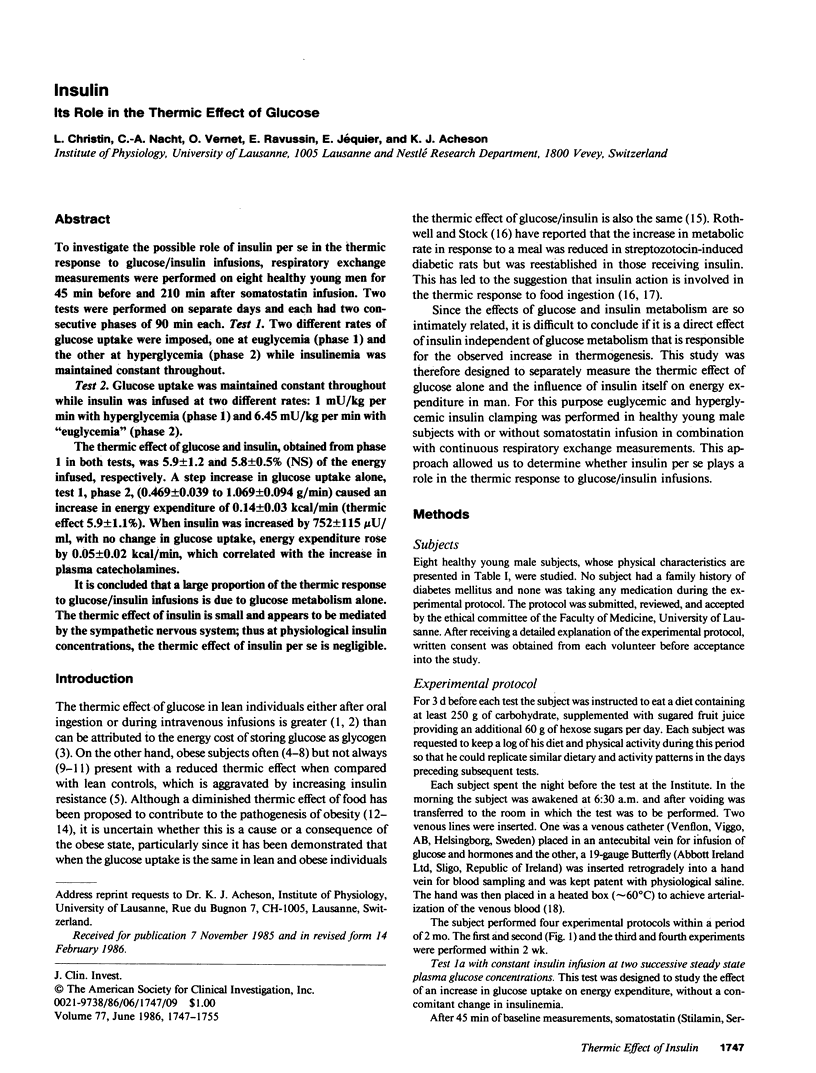
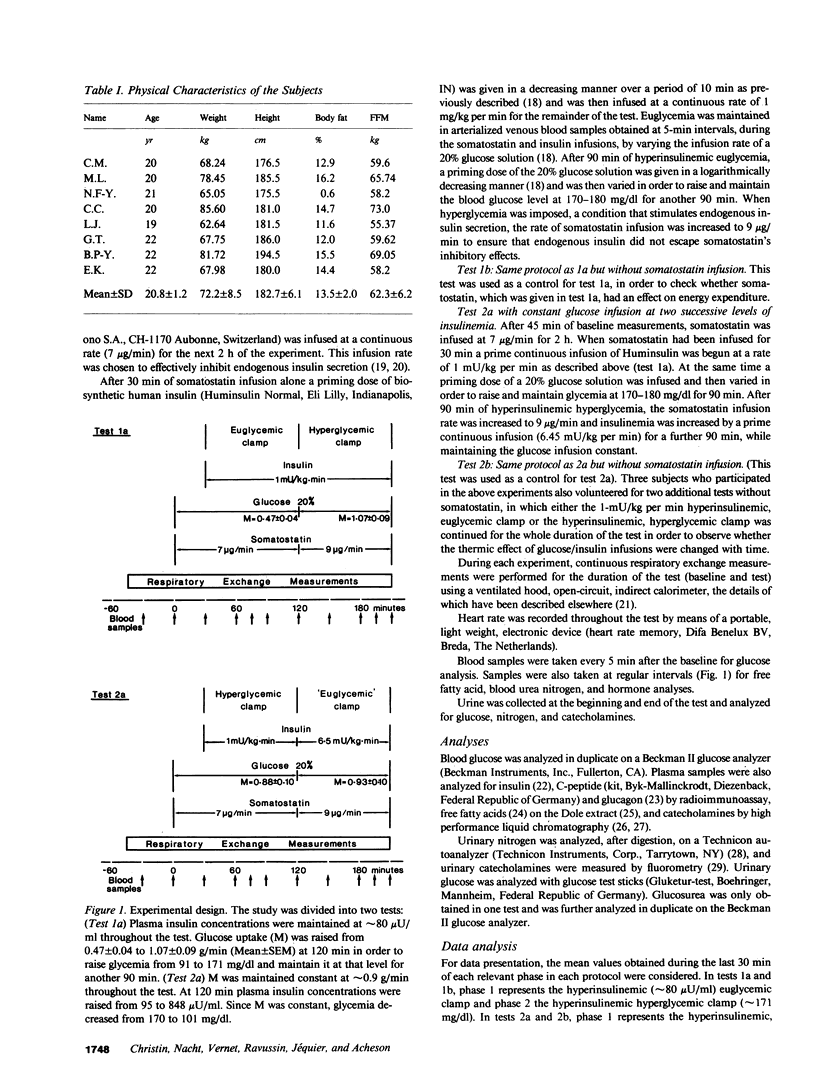
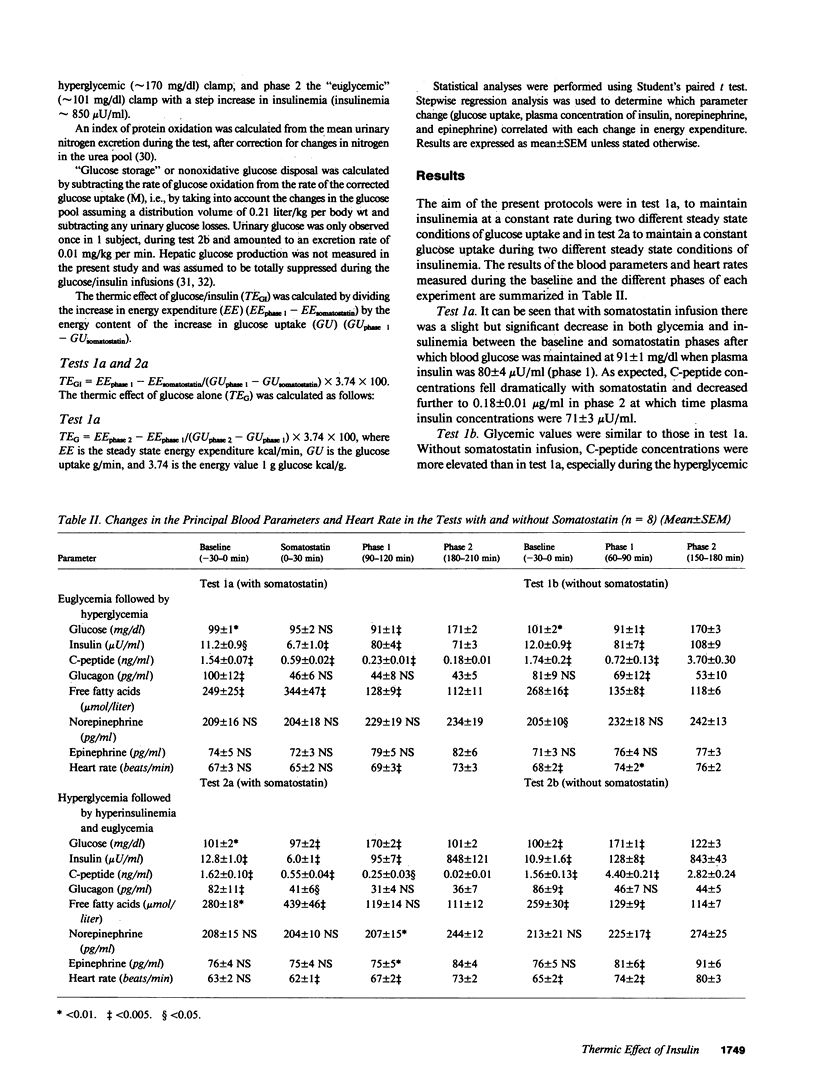
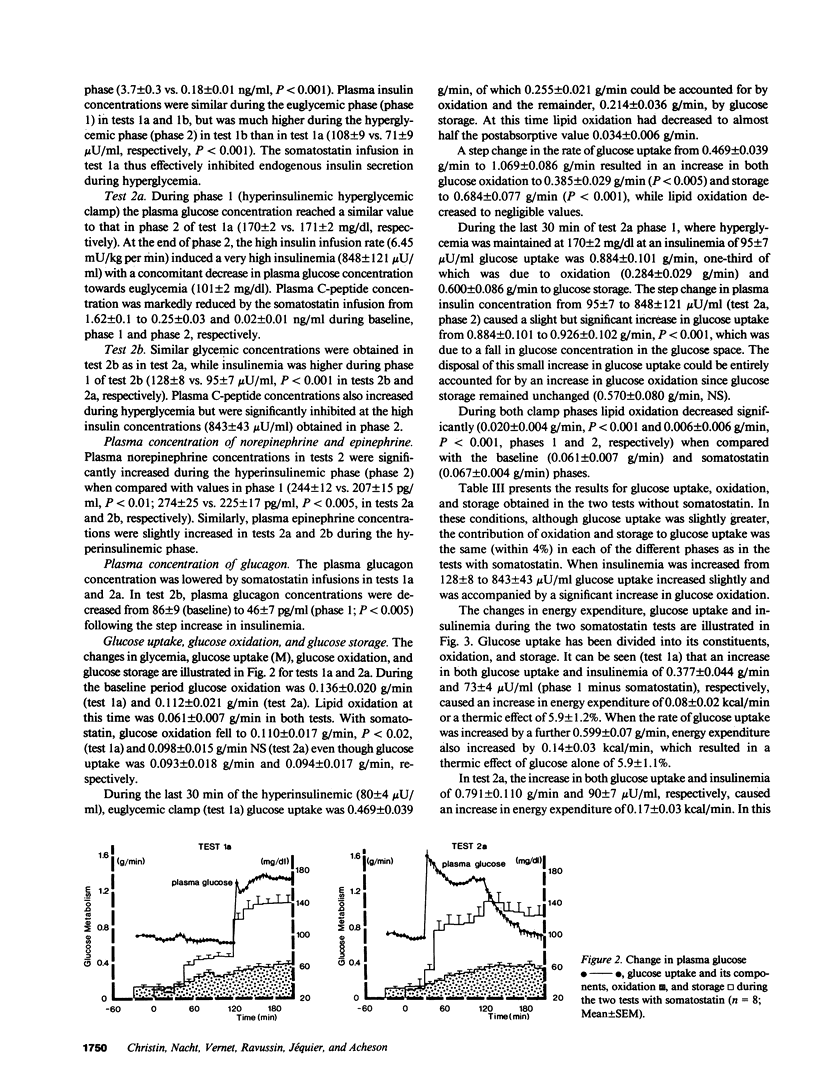
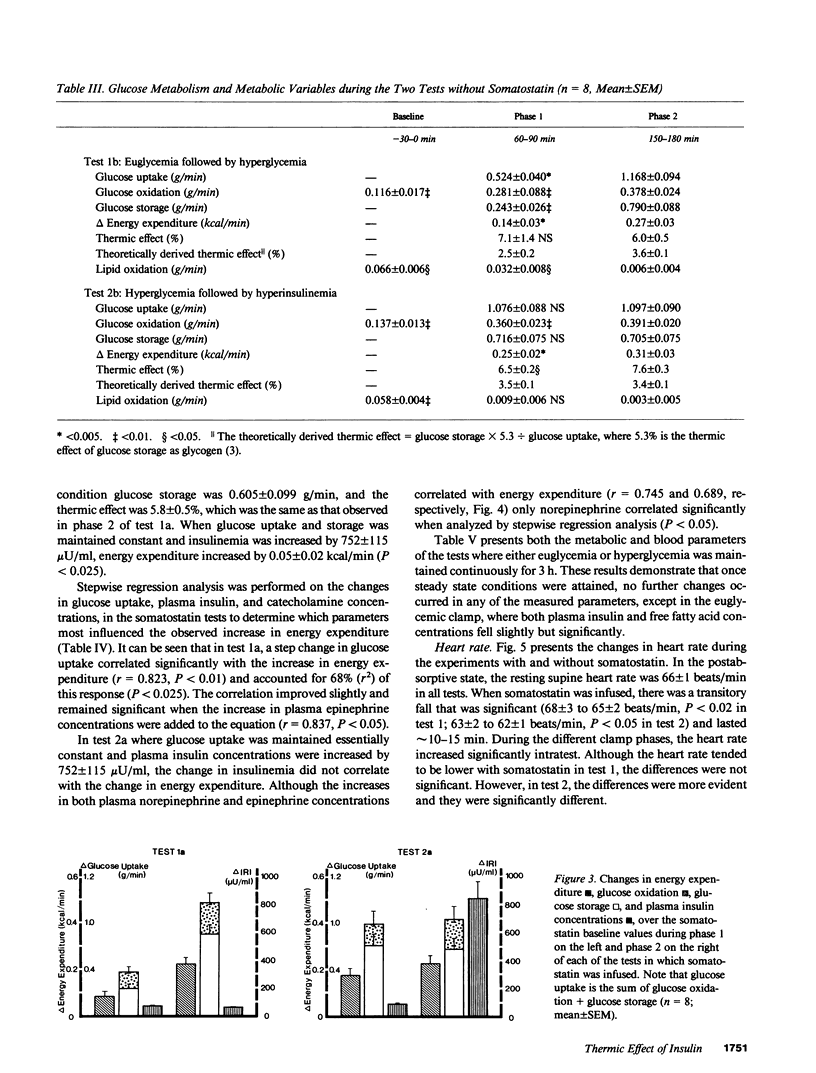
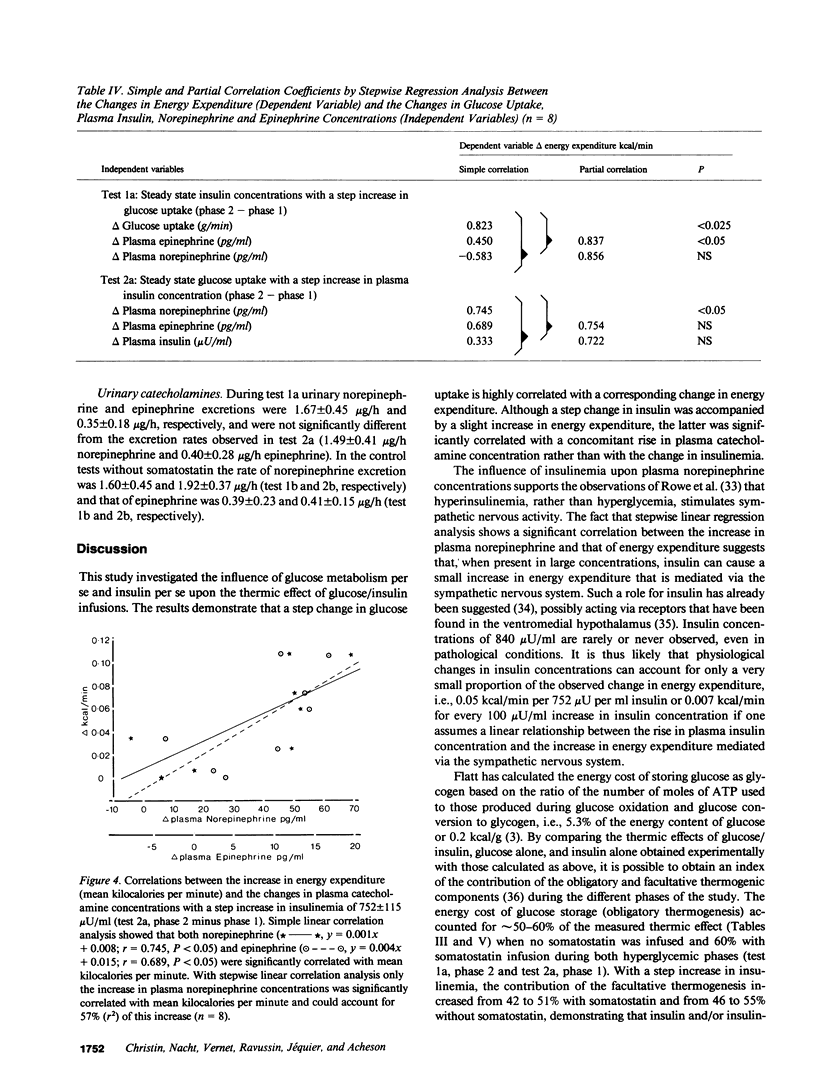
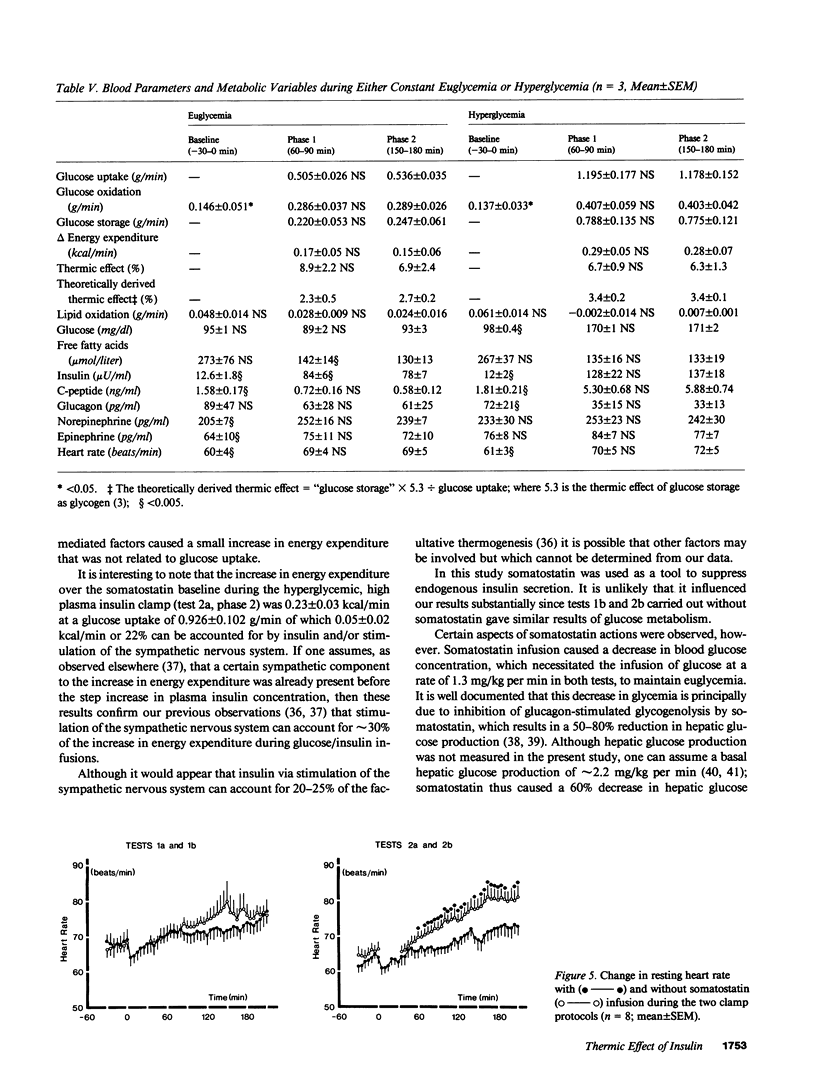
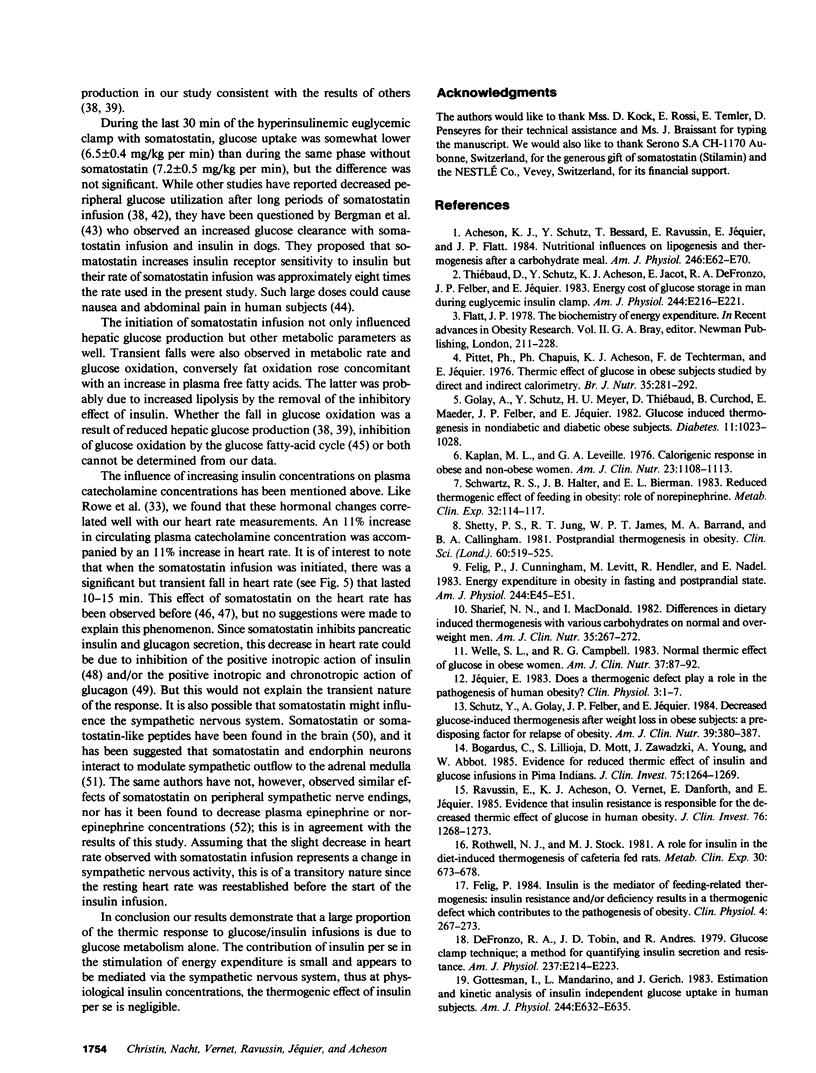
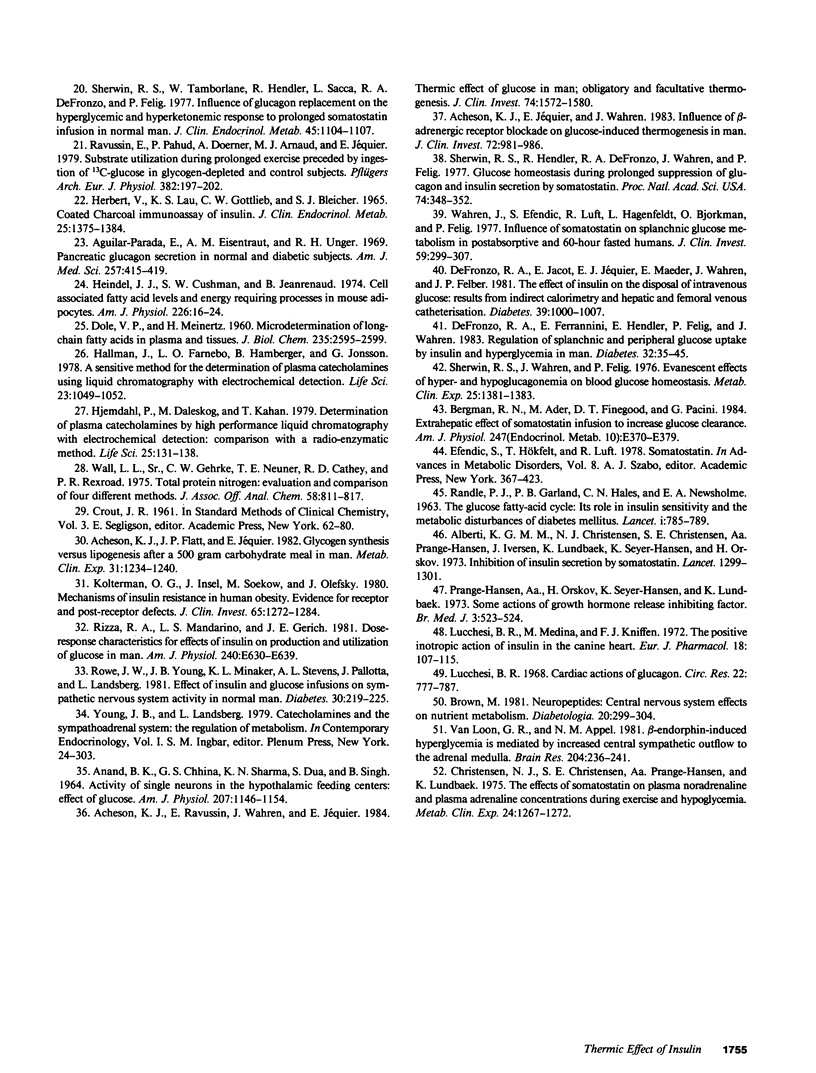
Selected References
These references are in PubMed. This may not be the complete list of references from this article.
- ANAND B. K., CHHINA G. S., SHARMA K. N., DUA S., SINGH B. ACTIVITY OF SINGLE NEURONS IN THE HYPOTHALAMIC FEEDING CENTERS: EFFECT OF GLUCOSE. Am J Physiol. 1964 Nov;207:1146–1154. doi: 10.1152/ajplegacy.1964.207.5.1146. [DOI] [PubMed] [Google Scholar]
- Acheson K. J., Flatt J. P., Jéquier E. Glycogen synthesis versus lipogenesis after a 500 gram carbohydrate meal in man. Metabolism. 1982 Dec;31(12):1234–1240. doi: 10.1016/0026-0495(82)90010-5. [DOI] [PubMed] [Google Scholar]
- Acheson K. J., Ravussin E., Wahren J., Jéquier E. Thermic effect of glucose in man. Obligatory and facultative thermogenesis. J Clin Invest. 1984 Nov;74(5):1572–1580. doi: 10.1172/JCI111573. [DOI] [PMC free article] [PubMed] [Google Scholar]
- Acheson K. J., Schutz Y., Bessard T., Ravussin E., Jéquier E., Flatt J. P. Nutritional influences on lipogenesis and thermogenesis after a carbohydrate meal. Am J Physiol. 1984 Jan;246(1 Pt 1):E62–E70. doi: 10.1152/ajpendo.1984.246.1.E62. [DOI] [PubMed] [Google Scholar]
- Acheson K., Jéquier E., Wahren J. Influence of beta-adrenergic blockade on glucose-induced thermogenesis in man. J Clin Invest. 1983 Sep;72(3):981–986. doi: 10.1172/JCI111070. [DOI] [PMC free article] [PubMed] [Google Scholar]
- Aguilar-Parada E., Eisentraut A. M., Unger R. H. Pancreatic glucagon secretion in normal and diabetic subjects. Am J Med Sci. 1969 Jun;257(6):415–419. doi: 10.1097/00000441-196906000-00008. [DOI] [PubMed] [Google Scholar]
- Alberti K. G., Christensen N. J., Christensen S. E., Hansen A. P., Iversen J., Lundbaek K., Seyer-Hansen K., Orskov H. Inhibition of insulin secretion by somatostatin. Lancet. 1973 Dec 8;2(7841):1299–1301. doi: 10.1016/s0140-6736(73)92873-0. [DOI] [PubMed] [Google Scholar]
- Bergman R. N., Ader M., Finegood D. T., Pacini G. Extrapancreatic effect of somatostatin infusion to increase glucose clearance. Am J Physiol. 1984 Sep;247(3 Pt 1):E370–E379. doi: 10.1152/ajpendo.1984.247.3.E370. [DOI] [PubMed] [Google Scholar]
- Bogardus C., Lillioja S., Mott D., Zawadzki J., Young A., Abbott W. Evidence for reduced thermic effect of insulin and glucose infusions in Pima Indians. J Clin Invest. 1985 Apr;75(4):1264–1269. doi: 10.1172/JCI111825. [DOI] [PMC free article] [PubMed] [Google Scholar]
- Brown M. Neuropeptides: central nervous system effects on nutrient metabolism. Diabetologia. 1981 Mar;20 (Suppl):299–304. [PubMed] [Google Scholar]
- Christensen N. J., Christensen S. E., Hansen A. P., Lundboek K. The effect of somatostatin on plasma noradrenaline and plasma adrenaline concentrations during exercise and hypoglycemia. Metabolism. 1975 Nov;24(11):1267–1272. doi: 10.1016/0026-0495(75)90064-5. [DOI] [PubMed] [Google Scholar]
- DOLE V. P., MEINERTZ H. Microdetermination of long-chain fatty acids in plasma and tissues. J Biol Chem. 1960 Sep;235:2595–2599. [PubMed] [Google Scholar]
- DeFronzo R. A., Ferrannini E., Hendler R., Felig P., Wahren J. Regulation of splanchnic and peripheral glucose uptake by insulin and hyperglycemia in man. Diabetes. 1983 Jan;32(1):35–45. doi: 10.2337/diab.32.1.35. [DOI] [PubMed] [Google Scholar]
- DeFronzo R. A., Jacot E., Jequier E., Maeder E., Wahren J., Felber J. P. The effect of insulin on the disposal of intravenous glucose. Results from indirect calorimetry and hepatic and femoral venous catheterization. Diabetes. 1981 Dec;30(12):1000–1007. doi: 10.2337/diab.30.12.1000. [DOI] [PubMed] [Google Scholar]
- DeFronzo R. A., Tobin J. D., Andres R. Glucose clamp technique: a method for quantifying insulin secretion and resistance. Am J Physiol. 1979 Sep;237(3):E214–E223. doi: 10.1152/ajpendo.1979.237.3.E214. [DOI] [PubMed] [Google Scholar]
- Felig P., Cunningham J., Levitt M., Hendler R., Nadel E. Energy expenditure in obesity in fasting and postprandial state. Am J Physiol. 1983 Jan;244(1):E45–E51. doi: 10.1152/ajpendo.1983.244.1.E45. [DOI] [PubMed] [Google Scholar]
- Felig P. Insulin is the mediator of feeding-related thermogenesis: insulin resistance and/or deficiency results in a thermogenic defect which contributes to the pathogenesis of obesity. Clin Physiol. 1984 Aug;4(4):267–273. doi: 10.1111/j.1475-097x.1984.tb00802.x. [DOI] [PubMed] [Google Scholar]
- Golay A., Schutz Y., Meyer H. U., Thiébaud D., Curchod B., Maeder E., Felber J. P., Jéquier E. Glucose-induced thermogenesis in nondiabetic and diabetic obese subjects. Diabetes. 1982 Nov;31(11):1023–1028. doi: 10.2337/diacare.31.11.1023. [DOI] [PubMed] [Google Scholar]
- Gottesman I., Mandarino L., Gerich J. Estimation and kinetic analysis of insulin-independent glucose uptake in human subjects. Am J Physiol. 1983 Jun;244(6):E632–E635. doi: 10.1152/ajpendo.1983.244.6.E632. [DOI] [PubMed] [Google Scholar]
- Hallman H., Farnebo L. O., Hamberger B., Johnsson G. A sensitive method for the determination of plasma catecholamines using liquid chromatography with electrochemical detection. Life Sci. 1978 Sep 11;23(10):1049–1052. doi: 10.1016/0024-3205(78)90665-3. [DOI] [PubMed] [Google Scholar]
- Hansen A. P., Orskov H., Seyer-Hansen K., Lundbaek K. Some actions of growth hormone release inhibiting factor. Br Med J. 1973 Sep 8;3(5879):523–524. doi: 10.1136/bmj.3.5879.523. [DOI] [PMC free article] [PubMed] [Google Scholar]
- Heindel J. J., Cushman S. W., Jeanrenaud B. Cell-associated fatty acid levels and energy-requiring processes in mouse adipocytes. Am J Physiol. 1974 Jan;226(1):16–24. doi: 10.1152/ajplegacy.1974.226.1.16. [DOI] [PubMed] [Google Scholar]
- Herbert V., Lau K. S., Gottlieb C. W., Bleicher S. J. Coated charcoal immunoassay of insulin. J Clin Endocrinol Metab. 1965 Oct;25(10):1375–1384. doi: 10.1210/jcem-25-10-1375. [DOI] [PubMed] [Google Scholar]
- Hjemdahl P., Daleskog M., Kahan T. Determination of plasma catecholamines by high performance liquid chromatography with electrochemical detection: comparison with a radioenzymatic method. Life Sci. 1979 Jul 9;25(2):131–138. doi: 10.1016/0024-3205(79)90384-9. [DOI] [PubMed] [Google Scholar]
- Jéquier E. Does a thermogenic defect play a role in the pathogenesis of human obesity? Clin Physiol. 1983 Feb;3(1):1–7. doi: 10.1111/j.1475-097x.1983.tb00692.x. [DOI] [PubMed] [Google Scholar]
- Kaplan M. L., Leveille G. A. Calorigenic response in obese and nonobese women. Am J Clin Nutr. 1976 Oct;29(10):1108–1113. doi: 10.1093/ajcn/29.10.1108. [DOI] [PubMed] [Google Scholar]
- Kolterman O. G., Insel J., Saekow M., Olefsky J. M. Mechanisms of insulin resistance in human obesity: evidence for receptor and postreceptor defects. J Clin Invest. 1980 Jun;65(6):1272–1284. doi: 10.1172/JCI109790. [DOI] [PMC free article] [PubMed] [Google Scholar]
- Lucchesi B. R. Cardiac actions of glucagon. Circ Res. 1968 Jun;22(6):777–787. doi: 10.1161/01.res.22.6.777. [DOI] [PubMed] [Google Scholar]
- Lucchesi B. R., Medina M., Kniffen F. J. The positive inotropic action of insulin in the canine heart. Eur J Pharmacol. 1972 Apr;18(1):107–115. doi: 10.1016/0014-2999(72)90137-9. [DOI] [PubMed] [Google Scholar]
- Pittet P., Chappuis P., Acheson K., De Techtermann F., Jéquier E. Thermic effect of glucose in obese subjects studied by direct and indirect calorimetry. Br J Nutr. 1976 Mar;35(2):281–292. doi: 10.1079/bjn19760033. [DOI] [PubMed] [Google Scholar]
- RANDLE P. J., GARLAND P. B., HALES C. N., NEWSHOLME E. A. The glucose fatty-acid cycle. Its role in insulin sensitivity and the metabolic disturbances of diabetes mellitus. Lancet. 1963 Apr 13;1(7285):785–789. doi: 10.1016/s0140-6736(63)91500-9. [DOI] [PubMed] [Google Scholar]
- Ravussin E., Acheson K. J., Vernet O., Danforth E., Jéquier E. Evidence that insulin resistance is responsible for the decreased thermic effect of glucose in human obesity. J Clin Invest. 1985 Sep;76(3):1268–1273. doi: 10.1172/JCI112083. [DOI] [PMC free article] [PubMed] [Google Scholar]
- Ravussin E., Pahud P., Dörner A., Arnaud M. J., Jéquier E. Substrate utilization during prolonged exercise preceded by ingestion of 13C-glucose in glycogen depleted and control subjects. Pflugers Arch. 1979 Nov;382(3):197–202. doi: 10.1007/BF00583702. [DOI] [PubMed] [Google Scholar]
- Rizza R. A., Mandarino L. J., Gerich J. E. Dose-response characteristics for effects of insulin on production and utilization of glucose in man. Am J Physiol. 1981 Jun;240(6):E630–E639. doi: 10.1152/ajpendo.1981.240.6.E630. [DOI] [PubMed] [Google Scholar]
- Rothwell N. J., Stock M. J. A role for insulin in the diet-induced thermogenesis of cafeteria-fed rats. Metabolism. 1981 Jul;30(7):673–678. doi: 10.1016/0026-0495(81)90082-2. [DOI] [PubMed] [Google Scholar]
- Rowe J. W., Young J. B., Minaker K. L., Stevens A. L., Pallotta J., Landsberg L. Effect of insulin and glucose infusions on sympathetic nervous system activity in normal man. Diabetes. 1981 Mar;30(3):219–225. doi: 10.2337/diab.30.3.219. [DOI] [PubMed] [Google Scholar]
- Schutz Y., Golay A., Felber J. P., Jéquier E. Decreased glucose-induced thermogenesis after weight loss in obese subjects: a predisposing factor for relapse of obesity? Am J Clin Nutr. 1984 Mar;39(3):380–387. doi: 10.1093/ajcn/39.3.380. [DOI] [PubMed] [Google Scholar]
- Schwartz R. S., Halter J. B., Bierman E. L. Reduced thermic effect of feeding in obesity: role of norepinephrine. Metabolism. 1983 Feb;32(2):114–117. doi: 10.1016/0026-0495(83)90214-7. [DOI] [PubMed] [Google Scholar]
- Sharief N. N., Macdonald I. Differences in dietary-induced thermogenesis with various carbohydrates in normal and overweight men. Am J Clin Nutr. 1982 Feb;35(2):267–272. doi: 10.1093/ajcn/35.2.267. [DOI] [PubMed] [Google Scholar]
- Sherwin R. S., Hendler R., DeFronzo R., Wahren J., Felic P. Glucose homeostasis during prolonged suppression of glucagon and insulin secretion by somatostatin. Proc Natl Acad Sci U S A. 1977 Jan;74(1):348–352. doi: 10.1073/pnas.74.1.348. [DOI] [PMC free article] [PubMed] [Google Scholar]
- Sherwin R. S., Tamborlane W., Hendler R., Saccá L., DeFronzo R. A., Felig P. Influence of glucagon replacement on the hyperglycemic and hyperketonemic response to prolonged somatostatin infusion in normal man. J Clin Endocrinol Metab. 1977 Nov;45(5):1104–1107. doi: 10.1210/jcem-45-5-1104. [DOI] [PubMed] [Google Scholar]
- Sherwin R., Wahren J., Felig P. Evanescent effects of hypo- and hyperglucagonemia on blood glucose homeostasis. Metabolism. 1976 Nov;25(11 Suppl 1):1381–1383. doi: 10.1016/s0026-0495(76)80146-1. [DOI] [PubMed] [Google Scholar]
- Shetty P. S., Jung R. T., James W. P., Barrand M. A., Callingham B. A. Postprandial thermogenesis in obesity. Clin Sci (Lond) 1981 May;60(5):519–525. doi: 10.1042/cs0600519. [DOI] [PubMed] [Google Scholar]
- Thiebaud D., Schutz Y., Acheson K., Jacot E., DeFronzo R. A., Felber J. P., Jequier E. Energy cost of glucose storage in human subjects during glucose-insulin infusions. Am J Physiol. 1983 Mar;244(3):E216–E221. doi: 10.1152/ajpendo.1983.244.3.E216. [DOI] [PubMed] [Google Scholar]
- Wahren J., Efendić S., Luft R., Hagenfeldt L., Björkman O., Felig P. Influence of somatostatin on splanchnic glucose metabolism in postabsorptive and 60-hour fasted humans. J Clin Invest. 1977 Feb;59(2):299–307. doi: 10.1172/JCI108641. [DOI] [PMC free article] [PubMed] [Google Scholar]
- Welle S. L., Campbell R. G. Normal thermic effect of glucose in obese women. Am J Clin Nutr. 1983 Jan;37(1):87–92. doi: 10.1093/ajcn/37.1.87. [DOI] [PubMed] [Google Scholar]
- van Loon G. H., Appel N. M. beta-Endorphin-induced hyperglycemia is mediated by increased central sympathetic outflow to adrenal medulla. Brain Res. 1981 Jan 5;204(1):236–241. doi: 10.1016/0006-8993(81)90671-5. [DOI] [PubMed] [Google Scholar]


